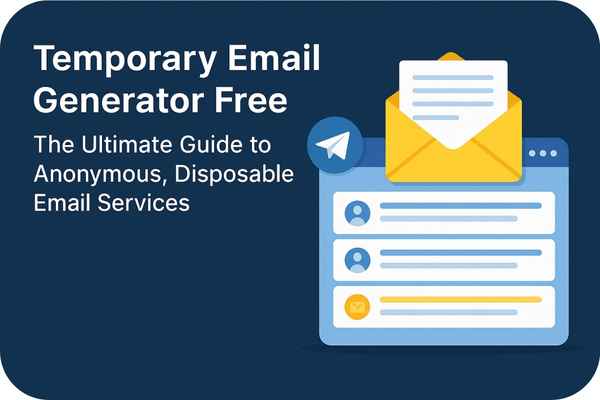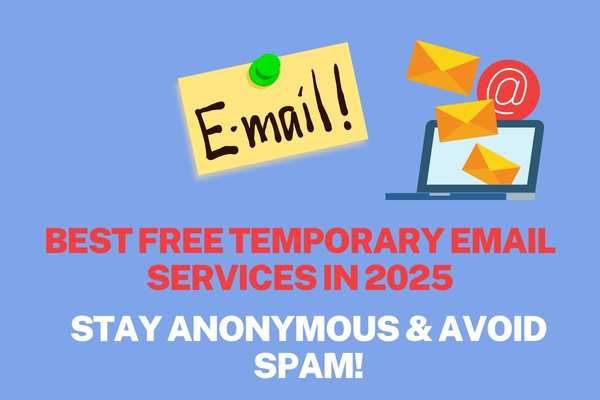Best Temporary Email Generator Free #1 – The Ultimate Guide to Anonymous, Disposable Email Services

Let’s face it—we live in a world where signing up for anything online means you’re about to get flooded with endless emails. Whether it’s spam, promotions, or even phishing attempts, giving out your real email can sometimes feel like handing out your phone number to a telemarketer. That’s where temporary email generators come in.
These handy tools create disposable email addresses that self-destruct after a certain period. You can use them to receive emails for a short time, typically minutes to hours, and then poof—they’re gone. No more junk, no more spam, no more lingering regrets.
Temporary email addresses have become the go-to solution for anyone who wants to protect their privacy, avoid spam, or just stay under the radar when trying out a new website or service. And the best part? Most of these services are absolutely free.
In this article, we’re going to explore everything there is to know about temporary email generators, from how they work to the best tools out there and tips to use them safely and efficiently.
What is a Temporary Email Address?
Basic Concept of Disposable Emails
A temporary email address is a short-lived, anonymous email account that lets you send and receive emails for a limited period—usually anywhere from 10 minutes to a few hours. These emails require no signup, no password, and often no personal information at all.
Think of it like a hotel room key card—you use it for a short stay, then it deactivates and you walk away, leaving no trace.
Temporary email services are typically used for:
-
Quick verification links
-
Anonymous signups
-
Avoiding data collection
-
Reducing email spam
Unlike regular email providers like Gmail or Outlook, temp emails are meant to be disposable. Once the session expires or the inbox is deleted, all emails are gone—forever.
How Temporary Emails Differ from Permanent Ones
Here’s a quick breakdown of the key differences between temp and traditional email accounts:
| Feature | Temporary Email | Permanent Email |
|---|---|---|
| Lifespan | Minutes to Hours | Indefinite |
| Registration Required | No | Yes |
| Inbox Storage | Short-term | Long-term |
| Identity Verification | Not Needed | Required (often phone number) |
| Recoverable | No | Yes |
| Ideal Use Case | Anonymous Signups | Personal/Business Use |
Temporary emails are optimized for speed and privacy, not long-term communication. You won’t get a calendar, cloud storage, or a personalized signature. But for one-time use cases, they’re perfect.
Why Use a Temporary Email Generator?
Benefits of Anonymous Emailing
We all want a little more privacy online. That’s where temp email generators come into play. These tools empower you to:
-
Stay Anonymous: No name, no ID, no phone number. Just a random address that does the job.
-
Bypass Signups: Many websites require an email just to show you basic content. Temp emails help you get around that.
-
Avoid Tracking: No cookies tied to your email, no marketing IDs, no behavioral profiles.
When using your real email, companies can track your activity across platforms using your email as a digital fingerprint. A temporary email gives you a clean slate every time you generate a new one.
Avoiding Spam and Data Breaches
You’ve probably signed up for something “just once” and ended up receiving newsletters daily. Or worse, your email address gets leaked in a data breach. With a disposable email, you avoid both scenarios.
Let’s not forget those sketchy websites asking for an email before you can download an eBook, try a tool, or view a video. These sites are often data harvesters in disguise. A temporary email shields your actual address from falling into the wrong hands.
In a world of increasing cyber threats, temp emails act like digital burner phones—offering just enough functionality without risking your primary inbox.
How Temporary Email Generators Work
Simple Steps to Create a Temp Email
Using a temporary email generator is often as easy as clicking a button. Here’s how it usually works:
-
Visit a Temporary Email Website (e.g., TempMail, Guerrilla Mail)
-
Automatically Get an Email Address displayed on the screen
-
Copy the Address and paste it into any signup or verification form
-
Wait for Incoming Emails in the same window or tab
-
Read and Respond (if supported) before the email expires
There’s no login, no installation, and no data retention beyond the session.
How Long Do Temp Emails Last?
The expiration time depends on the service provider. Most disposable emails self-delete after:
-
10 minutes (10 Minute Mail)
-
1 hour (Maildrop, EmailOnDeck)
-
Up to 24 hours (Guerrilla Mail, TempMail)
Some providers allow you to extend the lifespan or even make the email address permanent if you decide to sign up.
Inbox Features and Limitations
Don’t expect full Gmail-style capabilities. Temporary inboxes are simple and functional. Common features include:
-
Auto-refreshing inbox
-
Plaintext email previews
-
Basic attachments support (in some cases)
-
Random or customizable email addresses
What you won’t get:
-
Spam folders
-
Long-term archiving
-
Advanced search
-
Contact list management
But hey, you’re not here to build a relationship—you’re just here for a one-night stand with the internet.
Top Free Temporary Email Generator Tools
Temp Mail
Temp Mail is arguably the most well-known name in the disposable email world. It’s clean, easy to use, and refreshes itself automatically every few seconds to show any new messages you receive.
Here’s why it’s so popular:
-
No Sign-up Required: You just open the website and your email address is ready to go.
-
Cross-Device Compatibility: Works smoothly on both desktop and mobile.
-
Real-Time Inbox Updates: Emails appear instantly without needing a refresh.
-
Custom Domain Options: You can switch between different domains to bypass filters.
Temp Mail is ideal for when you need a temporary inbox fast, and you’re only expecting a message or two, like a verification code or activation link. It also offers a premium version if you want to get more control, like setting your own custom email name or extending your inbox’s life.
10 Minute Mail
As the name implies, 10 Minute Mail gives you exactly 10 minutes of mailbox time. It’s perfect when you want to get in and out without leaving a trace.
What makes 10 Minute Mail stand out:
-
Simple Interface: No buttons to press, just a clean screen with your email and inbox.
-
Auto-Copy Feature: The email is copied to your clipboard with a single click.
-
Timer Display: You’ll always know how much time is left on your email.
-
Extend Timer: If you need more time, you can easily reset or extend the countdown.
This tool is best for quick verifications like registering for a forum or claiming a discount coupon. But once those 10 minutes are up, the email—and everything in it—is gone forever.
Guerrilla Mail
One of the oldest in the game, Guerrilla Mail offers some extra customization options compared to other services.
Unique features include:
-
Custom Email Prefix: Choose your own username.
-
Multiple Domain Options: Helps avoid domain blacklisting by websites.
-
Supports Attachments: You can actually receive files up to 150MB.
-
Email Scrubbing: Removes embedded tracking pixels from emails.
It’s especially useful for developers or testers who need to go beyond just reading emails. Plus, Guerrilla Mail has a no-nonsense approach to privacy—everything gets wiped clean after an hour.
EmailOnDeck
EmailOnDeck is another top-rated disposable email provider with a fast setup process and a user-friendly design.
What to expect:
-
Easy Two-Step Creation: Click “Get Email,” solve a CAPTCHA, and you’re good to go.
-
High Deliverability: Works well for verification emails from major sites.
-
Encrypted Connection: HTTPS encryption keeps your session secure.
-
Professional Interface: It looks more like a traditional inbox than most other services.
This one is great if you’re signing up for something that may take a little longer—like downloading a file or completing an online quiz.
Comparing the Best Temporary Email Services
Feature Table – What Each Tool Offers
Let’s break it down in a table to make your choice easier:
| Service | Time Limit | Custom Address | Attachments | Mobile Friendly | Inbox Refresh |
|---|---|---|---|---|---|
| Temp Mail | 1-24 hrs | No (Free) | Yes | Yes | Yes |
| 10 Minute Mail | 10 mins | No | No | Yes | Yes |
| Guerrilla Mail | 1 hr | Yes | Yes (150MB) | Yes | Yes |
| EmailOnDeck | Varies | No | No | Yes | Yes |
Each tool has its own strengths. Choose Temp Mail for long sessions, Guerrilla Mail for power usage, 10 Minute Mail for speed, and EmailOnDeck for a sleek experience.
Usability and Interface Experience
The user experience plays a huge role in how convenient these tools are. While most temporary email generators keep things bare-bones, some stand out:
-
EmailOnDeck feels closest to a regular email service.
-
10 Minute Mail wins for simplicity and ease of access.
-
Guerrilla Mail has a retro vibe but offers powerful tools for power users.
Ultimately, it depends on what you need more: speed, simplicity, or features.
Security and Privacy Ratings
When it comes to anonymity, not all temp mail services are created equal. Some store logs, some don’t. Some offer HTTPS-only connections, while others might expose your data.
Here’s how they stack up in terms of privacy:
-
Guerrilla Mail: Very privacy-focused. It doesn’t store emails after expiry and strips out trackers.
-
Temp Mail: Good HTTPS security, but some versions display ads that might track usage.
-
10 Minute Mail: Minimal logging and fast self-destruction keep things secure.
-
EmailOnDeck: Uses encryption and deletes emails after a short period.
When Should You Use Temporary Emails?
Signing Up for Free Trials
Many websites and apps offer free trials but require an email to start. Unfortunately, they also lock your real address into their marketing lists.
Using a temporary email lets you:
-
Access free trials without giving out your real contact info.
-
Avoid unwanted newsletters and upsell emails.
-
Use multiple trials with different temp emails.
It’s a clever way to test new tools or services risk-free.
Avoiding Newsletters and Promotions
Ever enter a giveaway and suddenly get flooded with newsletters? That’s where a temporary email is your best friend. You can sign up, confirm your entry, and never hear from them again.
-
Use it for contests, promotions, or coupon codes.
-
Avoid giving out your personal email on sketchy landing pages.
-
Sign up for ebooks, whitepapers, and webinars without the follow-up spam.
Testing Websites or Apps
If you’re a developer, marketer, or just someone testing new platforms, temp emails come in handy:
-
Check email-based workflows like password resets or user activation flows.
-
Create multiple test accounts easily.
-
Use anonymous emails for bug reporting or feedback submission.
It’s a must-have tool for QA teams and developers.
Are Temporary Email Generators Safe?
Risks Involved and How to Stay Secure
While temporary emails offer anonymity, they come with a few caveats:
-
No Encryption: Some services do not encrypt the content of the emails.
-
Public Inboxes: Many temp email addresses are shared, meaning others could see your emails.
-
No Authentication: Anyone with the link can access your inbox.
To stay secure:
-
Never use temp emails for sensitive data (like banking or health info).
-
Clear your browser cache after use.
-
Use HTTPS-only services to avoid man-in-the-middle attacks.
Legal Concerns and Ethical Usage
Using temp emails isn’t illegal, but how you use them matters. Avoid using them to:
-
Bypass legal restrictions
-
Spam websites or services
-
Create fake identities for fraud
Use them ethically for privacy, testing, and spam reduction—not for shady business.
Advantages of Using Free Temporary Email Services
Saves Time and Hassle
Creating a new Gmail or Outlook account just to sign up for a single website is overkill. It takes time, needs verification, and asks for a ton of personal info. With a temporary email, you skip all of that.
Here’s how it simplifies your life:
-
Instant Access: You get a fully functional email address in seconds.
-
No Passwords to Remember: Since the email self-destructs, you don’t need to store or manage any login credentials.
-
No Setup Required: No need to link a phone number, agree to privacy policies, or fill in personal details.
For those who frequently test apps, download freebies, or access gated content, temp emails are like a digital swiss army knife—quick, efficient, and ready for action.
Helps Protect Your Identity
Every time you hand out your real email, you’re giving companies a piece of your online identity. They can track your behavior, sell your data, and flood your inbox with offers. Temporary emails are the mask you wear online.
They:
-
Break the tracking chain that starts with your primary inbox.
-
Prevent data leaks from affecting your main email account.
-
Shield you from phishing attempts that target your real address.
Think of it like a burner phone for the digital world. You stay anonymous, untrackable, and worry-free.
Limitations of Temporary Emails
No Recovery Options
Let’s say you register for a service using a temp email and later forget your password. Bad news: there’s no way to recover that email, reset your password, or access your account.
That’s because temp emails:
-
Are not password-protected or linked to a user account.
-
Self-destruct after a short window.
-
Cannot store or forward messages long-term.
So, if you’re using it for something important or long-term, think twice. Use a real email with recovery options in such cases.
Emails May Expire Quickly
The biggest downside of temporary emails is right there in the name: temporary.
Depending on the service:
-
You might have as little as 10 minutes to read the email.
-
After expiration, all data is gone permanently.
-
Some sites block temp email domains, rendering them useless.
If the site takes time to send the confirmation or verification link, you might lose access before it even arrives.
That’s why it’s crucial to know your purpose. If you’re testing something fast or claiming a one-time offer, you’re golden. If it’s a subscription or account you’ll need to access again, stick to your real email.
Tips for Using Temporary Emails Effectively
Keep Track of Usage Time
Since most temp email services have strict time limits, it’s smart to keep an eye on the clock:
-
Use services like 10 Minute Mail with visible countdowns.
-
Bookmark or keep the email tab open so you don’t lose it.
-
Act fast—copy and paste the verification code or link as soon as it arrives.
You don’t want to miss an important message because you got distracted or refreshed the page.
Avoid Using for Sensitive Information
Temporary emails are not secure vaults. In fact, many are public-facing, meaning anyone with the right URL could potentially see the inbox.
Avoid using them for:
-
Banking or financial accounts
-
Healthcare or medical information
-
Business or work-related accounts
Think of temp emails as disposable napkins—not fine china. They’re great for quick cleanups but not meant to handle anything fragile or important.
Can You Use Temporary Emails for Social Media?
Which Platforms Accept Temp Emails
Social media platforms are increasingly savvy about detecting disposable email domains. Still, some platforms may allow them temporarily during the signup phase.
Here’s a breakdown:
-
Facebook, Instagram, Twitter: Generally block temp domains.
-
Reddit, Quora, Pinterest: Sometimes allow temp emails but may request a permanent one later.
-
Discord and Telegram: May accept temporary emails but require phone verification later.
Some clever users bypass these restrictions using:
-
Less-known temporary email providers that aren’t blacklisted.
-
Custom domain options offered by services like Guerrilla Mail.
But remember, even if you get through the door, your account might not be recoverable if flagged, banned, or hacked.
Workarounds and Limitations
If you’re insistent on using temp emails for social platforms:
-
Use less popular domains that aren’t on blacklists.
-
Try catch-all services or aliases from custom domains.
-
Combine temp email with temporary phone numbers for multi-step verifications.
Still, it’s not ideal for long-term accounts. Use temp email only if you’re testing, running bots, or creating throwaway profiles.
Browser Extensions and Mobile Apps for Temp Email
Convenient Tools for Quick Access
Some temp email generators come with browser extensions and mobile apps that make the process even faster. With these, you don’t have to visit a website every time—you can generate and paste emails on the go.
Popular tools include:
-
Temp Mail Chrome Extension: One-click address generation and inbox access.
-
Guerrilla Mail Add-On: Lets you manage multiple disposable inboxes from your toolbar.
-
10 Minute Mail Widget: Lightweight and minimalist, perfect for mobile use.
They’re ideal for heavy users—developers, testers, marketers—who need disposable emails frequently.
Recommended Chrome Extensions
Here are some of the best Chrome extensions for temp mail usage:
| Extension Name | Provider | Features |
|---|---|---|
| Temp Mail | temp-mail.org | Auto-copy, real-time inbox |
| Burner Mail | burnermail.io | Create aliases for every site |
| Email Temporário | 10 Minute Mail | Instant generation, alerts |
| Moakt | moakt.com | Multiple domain options |
Make sure to check reviews and permissions before installing. Some extensions may request access to your browsing data—only use trusted sources.
Self-Hosted Temporary Email Solutions
Setting Up Your Own Temp Mail Server
If you’re technically inclined and value complete privacy, setting up your own temporary email server might be the best route. It gives you full control over email lifespans, domain usage, and data retention.
To self-host your temp email server, you’ll need:
-
A VPS or dedicated server with a domain name
-
Email server software like Mailcow, Postfix, or Mailu
-
Temporary mailbox scripts that automatically delete or archive emails after a set time
-
Spam filters and SSL certificates for protection
Benefits of hosting your own solution:
-
No third-party tracking
-
Custom domains and email addresses
-
Adjustable email expiration time
-
Private inboxes only you control
This approach is more complex but perfect for developers, sysadmins, or privacy-focused businesses.
Open Source Tools to Explore
Want to skip building from scratch? Use open-source platforms designed for temp mail hosting:
-
Maildrop – Minimal, open-source temp email with basic inbox features.
-
Haraka – A high-performance Node.js SMTP server ideal for developers.
-
TrashMail – Offers both hosted and self-hosted versions.
These tools give you freedom and security without being locked into a third-party platform.
Future of Disposable Email Services
AI Integration and Smarter Inbox Handling
The future of temporary email lies in automation and intelligence. AI is expected to revolutionize how we manage disposable emails:
-
Smart filtering to highlight important messages and block spam.
-
Auto-expiration control that adjusts inbox life based on activity.
-
Predictive inboxes that pre-load verification links or extract codes.
Some services may soon start integrating voice assistants, chatbots, or browser-side encryption to keep user privacy intact while improving user experience.
Trends in Privacy and Anonymity
As internet users become more aware of data exploitation, the demand for anonymous tools is skyrocketing. Expect more providers to:
-
Offer premium plans with encryption and private domains.
-
Integrate VPNs or proxy routing to mask IP addresses.
-
Develop mobile-first platforms for easier access.
Legislation like the GDPR and growing privacy scandals are making disposable email a more mainstream necessity rather than a niche tool.
Conclusion
In a world overflowing with spam, intrusive marketing, and data leaks, temporary email generators have become a modern necessity. Whether you’re signing up for a free trial, accessing a one-time download, or just trying to keep your inbox clutter-free, these tools offer a fast, free, and anonymous solution.
We’ve walked through the top providers like Temp Mail, 10 Minute Mail, and Guerrilla Mail, compared their features, and explored best practices for safe use. We also discussed how to self-host a temp mail server for ultimate control.




